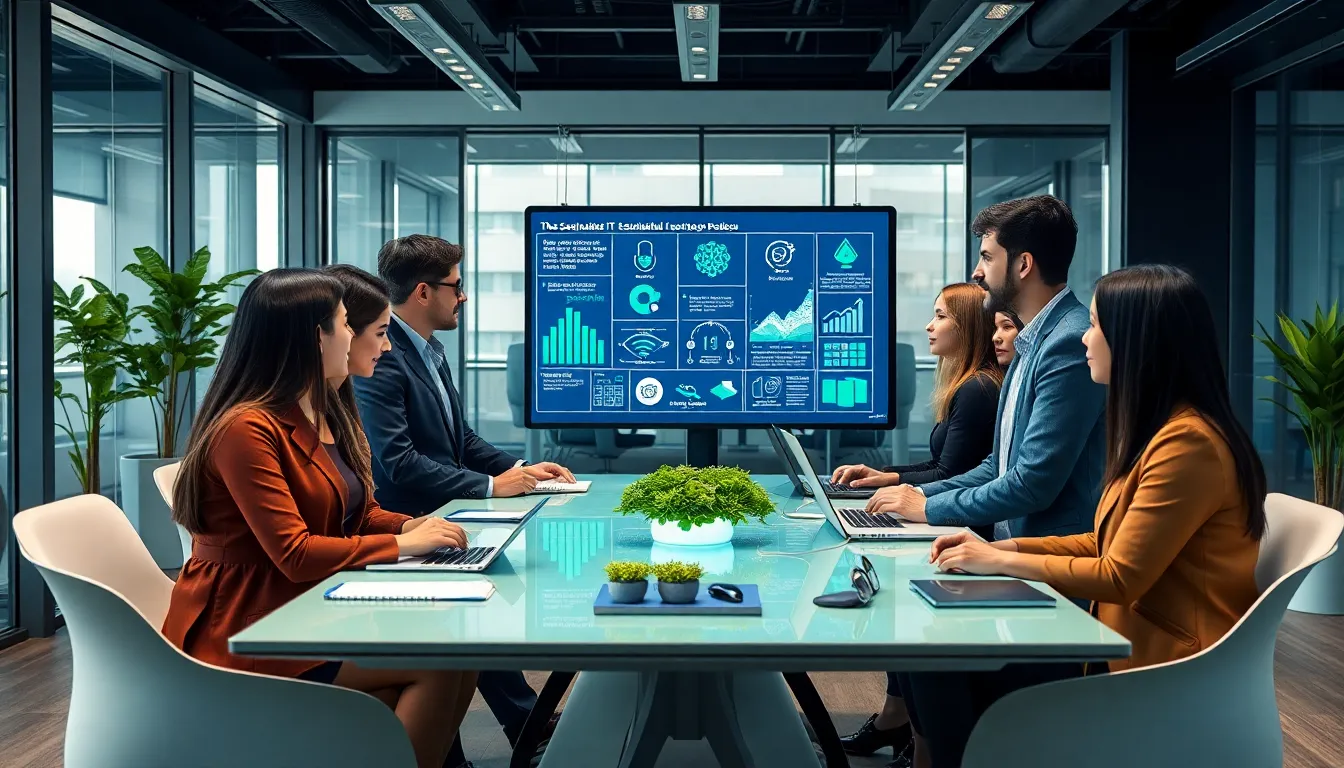Table of Contents
ToggleIn a world where tech leaders juggle innovation and sustainability like a circus act, the stakes have never been higher. With climate change knocking at the door and companies racing to go green, it’s time to trade in that old playbook for a fresh, sustainable approach. After all, who says saving the planet can’t be as exciting as launching the latest gadget?
Overview of Sustainable IT
Sustainable IT encompasses practices that minimize environmental impact while maximizing efficiency in technology management. Strategies include utilizing energy-efficient hardware, implementing cloud solutions, and optimizing data centers for reduced energy consumption. Technology leaders focus on lifecycle assessments to evaluate the ecological impact of products from creation to disposal.
Data shows that organizations can significantly reduce their carbon footprint by shifting to renewable energy sources. Companies that prioritize sustainable IT practices not only contribute to ecological preservation but also enhance their brand reputation. Numerous studies indicate that customers prefer brands demonstrating environmental responsibility.
The adoption of circular economy principles further strengthens sustainable IT efforts. Circular economy practices encourage reuse and recycling, diminishing waste generation. Leaders can facilitate this transition by creating programs that support the refurbishment of existing devices and promoting device buyback initiatives.
Collaboration across departments ensures a unified approach to sustainability. Engaging with stakeholders allows technology leaders to align sustainability goals with business objectives. Additionally, investing in employee training fosters a culture of sustainability, empowering teams to innovate responsibly.
Monitoring progress through sustainability metrics provides insight into the effectiveness of initiatives. Metrics such as energy consumption, carbon emissions, and resource utilization enable leaders to make informed decisions. Regular assessments lead to continuous improvement and reinforce accountability within the organization.
Ultimately, sustainable IT represents a crucial shift in the technology landscape, where eco-friendliness intertwines with innovation, driving future advancements. Prioritizing these efforts helps set a foundation for long-term success, balancing organizational growth with environmental stewardship.
Importance of Sustainability in IT

Sustainability plays a crucial role in shaping the future of information technology. It highlights the need for responsible resource use while fostering innovation in the industry.
Environmental Impact
Sustainable IT practices directly lessen environmental harm. Organizations that prioritize energy-efficient hardware and renewable energy lead to significant reductions in carbon emissions. Implementing cloud solutions minimizes reliance on physical infrastructure while optimizing resource use. Lifecycle assessments provide vital insights into a product’s ecological footprint. Emphasizing recycling and reuse principles further enhances waste reduction. Tech leaders who advocate for sustainable solutions contribute to a healthier planet and fulfill societal expectations.
Economic Benefits
Investing in sustainability creates economic advantages for companies. Reduced energy consumption often leads to lower operational costs, increasing profitability. Sustainable practices attract environmentally conscious consumers, enhancing brand loyalty. Companies demonstrating commitment to sustainability can access new markets and investment opportunities. Additionally, compliance with stringent regulations can prevent costly fines. Tracking sustainability metrics allows organizations to continuously improve operations, driving efficiency and cost savings. Sustainable IT efforts position companies favorably in a competitive market.
Key Components of the Sustainable IT Playbook
A sustainable IT playbook includes critical components that guide technology leaders toward eco-friendly practices. By focusing on energy efficiency, sustainable sourcing, and waste reduction, organizations enhance their environmental impact.
Energy Efficiency Strategies
Implementing energy-efficient hardware stands at the forefront of sustainable practices. Organizations benefit from using energy-saving devices and optimizing existing infrastructure. Cloud solutions provide additional efficiency gains by reducing data center energy consumption. Regular assessments help track energy use and identify areas for improvement. Utilizing virtualization techniques can optimize server use, cutting down on overhead. Many companies achieve significant cost savings while lowering their carbon footprint.
Sustainable Sourcing and Procurement
Sustainable sourcing focuses on procuring materials with minimal environmental impact. This approach includes selecting suppliers committed to eco-friendly practices. Organizations prioritize vendors utilizing renewable resources or participating in ethical labor practices. Evaluating the lifecycle sustainability of products ensures decisions align with environmental goals. Engaging in responsible procurement strategies can also enhance brand reputation and foster customer loyalty. Investing in local suppliers reduces transportation emissions and supports community economies.
Waste Reduction Techniques
Adopting waste reduction techniques plays a crucial role in the sustainable IT framework. Fostering a culture of recycling within the organization can significantly cut e-waste. Programs that promote device refurbishment and reuse extend the lifecycle of technology products. Streamlining packaging and reducing single-use materials can further minimize waste creation. Tracking waste generation and diversion rates offers insights into areas for improvement. Continuous evaluation encourages adopting more sustainable practices across all operations.
Implementing the Playbook
Implementing a sustainable IT playbook requires strategic actions and diligent tracking. Technology leaders play a crucial role in this transformation, ensuring alignment between sustainability and business goals.
Steps for Technology Leaders
First, technology leaders must assess current practices against sustainability benchmarks. Next, they should prioritize energy-efficient solutions such as hardware upgrades and cloud services to minimize energy consumption. Engaging employees through training fosters a culture of sustainability, integrating eco-friendly practices into daily operations. Collaborating with suppliers committed to sustainable sourcing enhances the overall supply chain. Frequent evaluations of processes will help leaders identify areas for improvement and ensure continuous progress toward sustainability goals.
Measuring Success
Establishing key performance indicators (KPIs) enables organizations to measure their sustainability initiatives effectively. Tracking energy consumption and emissions reductions offers critical insights into progress. Conducting regular lifecycle assessments provides detailed evaluations of product impacts from creation to disposal. Utilizing sustainability reporting tools can facilitate transparency and accountability for stakeholders. Engaging customers through feedback on eco-friendly products demonstrates commitment to environmental responsibility.
Challenges and Solutions
Tech leaders encounter various challenges on the path to implementing sustainable IT practices. Resistance to change often hinders progress. Many organizations rely on outdated technologies, making it difficult to transition to eco-friendly alternatives. Securing buy-in from stakeholders is crucial; alignment across departments reinforces sustainability objectives.
Resource constraints create another significant challenge. Tech leaders may face budget limitations when investing in energy-efficient hardware or cloud solutions. Identifying economical options can assist in overcoming this obstacle. Few companies utilize lifecycle assessments to evaluate product impacts effectively. Understanding these assessments strengthens the decision-making process.
Employee engagement frequently presents an additional hurdle. Workers may lack awareness of sustainable practices; therefore, implementing training programs is essential. Leadership must cultivate a culture of sustainability, which enhances productivity and commitment among staff. Measuring progress is another vital aspect. Setting key performance indicators allows tech leaders to track energy consumption and emissions reductions accurately.
Innovative solutions promote success despite challenges. Collaborating with suppliers committed to sustainability can streamline procurement processes. Utilizing cloud-based solutions optimizes resource efficiency and reduces energy consumption effectively. Encouraging the refurbishment and recycling of devices helps minimize e-waste instantly.
Tracking KPIs offers real-time insights into sustainability efforts. Regularly reviewing performance metrics enables organizations to make informed adjustments. Overcoming these challenges ultimately involves a strategic commitment to sustainability that balances operational efficiency and environmental responsibility.
Embracing a sustainable IT playbook is no longer optional for technology leaders; it’s essential for future success. By integrating eco-friendly practices into their operations, organizations not only reduce their environmental footprint but also position themselves as leaders in innovation.
The journey toward sustainability requires commitment and collaboration across all departments. By prioritizing energy-efficient solutions and fostering a culture of sustainability, tech leaders can drive meaningful change.
As the demand for responsible business practices grows, those who invest in sustainable IT will reap the benefits of enhanced brand loyalty and access to new markets. The path to a greener future is clear, and it’s time for technology leaders to take bold steps forward.




